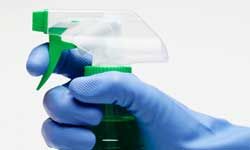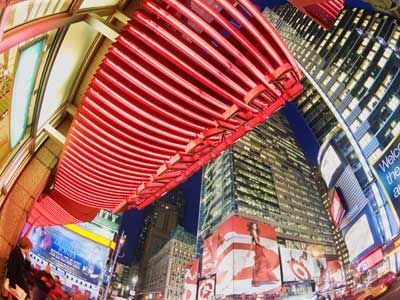Key Takeaways
- On a spray bottle, the trigger lever, pump and one-way valves work together to create a pressurized spray.
- A piston and cylinder mechanism, activated by pulling the trigger, force liquid up from the reservoir through a nozzle.
- The design usess one-way valves to ensure fluid flows in a single direction during operation, maintaining the suction required for the spray and preventing backflow into the reservoir.
Spray bottles are an extremely useful type of machine and an excellent demonstration of basic plumbing principles. A spray-bottle head is made up of only a few parts. It has a trigger lever, which activates a small pump. This pump is attached to a plastic tube that draws cleaning fluid from the bottom of the reservoir. The pump forces this liquid down a narrow barrel and out a small hole at the gun's muzzle. The hole, or nozzle, serves to focus the flowing liquid so that it forms a concentrated stream.
The only complex element in this design is the fluid pump, and it's about as simple as they come. The main moving element is a piston, housed inside a cylinder. Inside the cylinder, there is a small spring. To operate the pump, you pull the trigger back, pushing the piston into the cylinder. The moving piston compresses the spring, so when you release the trigger, the piston is pushed back out of the cylinder. These two strokes of the piston, into the cylinder and out again, constitute the entire pump cycle.
Advertisement
The downstroke, the piston pushing in, shrinks the area of the cylinder, forcing fluid out of the pump. The upstroke, the spring pushing the piston back out, expands the cylinder area, sucking fluid into the pump. In a spray bottle, you need to suck cleaning fluid in from the reservoir below and force it out through the barrel above. In order to get all of the fluid moving through the barrel, the pump must only force the fluid up -- it cannot force the fluid back into the reservoir. In other words, the fluid must move through the pump in only one direction.
The device that makes this possible is called a one-way valve. A spray bottle has two one-way valves in the pumping system: one between the pump and the reservoir and one between the pump and the nozzle. Typically, the valve between the pump and the reservoir consists of a tiny rubber ball that rests neatly inside a small seal. The sides of the seal are angled so that the ball won't fall through. Depending on the design, either gravity or a small spring holds this ball against the seal so that the water passageway is blocked off when you are not pumping. When the piston moves out (when you release the trigger), the expanding area of the cylinder sucks on the fluid below, pulling the ball up out of the seal. Since the ball is lifted up, fluid is free to flow from the reservoir. But when you squeeze the trigger, the outward force of the moving fluid pushes the ball into the seal, blocking off the passageway to the reservoir. Consequently, the pressurized fluid is pushed only into the barrel.
In a spray mechanism, the one-way valve between the pump and the nozzle is a sort of cup, which fits over the end of the barrel. On the upstroke, the inward pressure from the pump pulls the cup against the barrel, so air can't flow in through the nozzle. On the downstroke, the fluid pushing out lifts the cup off the barrel slightly and flows on through the nozzle. Without this second one-way valve, the pump system wouldn't be able to draw fluid up from the reservoir because there would be no suction (no drop in air pressure). The upstroke wouldn't lower the air pressure in the pump; it would only draw in more air to maintain that pressure.
This valve also works as a shut-off system. When you screw the nozzle piece in, it pushes the valve cup tightly against the barrel, so you can't force any liquid out. When you loosen the nozzle piece, there is enough room for the valve cup to move back and forth.
When you use a spray bottle for the first time, you have to squeeze the trigger a couple of times to spray any cleaning fluid. There are two things causing this delay:
- Before you start pumping, the gun is set for a downstroke, not an upstroke (the piston is sitting outside the cylinder). When you first pull the trigger back, and the piston pushes in, there is no liquid to pump out; there is only air in the cylinder chamber. The piston has to slide out to suck any fluid from the reservoir.
- On this first upstroke, the pump starts sucking the cleaning liquid from the reservoir. But it also sucks in any air sitting in the plastic tube leading to the reservoir. Before you can start spraying the cleaning liquid, you have to drive this air through the pump mechanism. This may take a couple of downstrokes and upstrokes.
This simple pump design, called a reciprocating piston pump, is used for a variety of tasks. In addition to pressurizing water, air and many other fluids, this design can also extract water and oil from underground. We even have reciprocating pumps built into our bodies: Your heart expands to draw low-pressure blood in through one one-way valve and contracts to force high-pressure blood through another one-way valve, back into your body. The same basic mechanism that makes an ordinary spray bottle work also serves to keep you alive!
Advertisement


